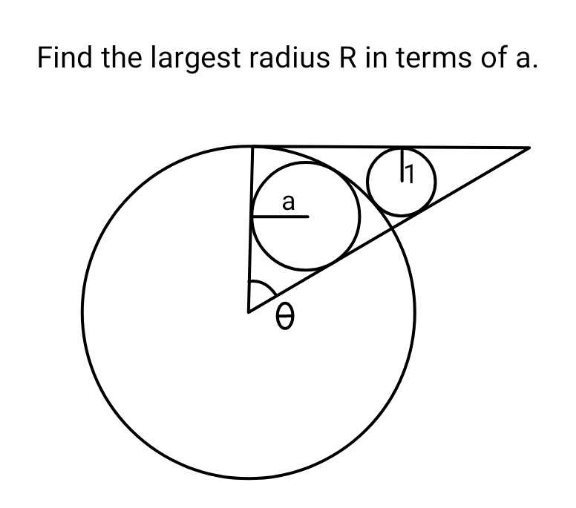
Question Number 204197 by ajfour last updated on 08/Feb/24

Answered by mr W last updated on 08/Feb/24

$$\mathrm{sin}\:\frac{\theta}{\mathrm{2}}=\frac{{a}}{{R}−{a}} \\ $$$${OC}={OB}+{BC} \\ $$$$\frac{{R}}{\mathrm{cos}\:\theta}=\sqrt{\left({R}+\mathrm{1}\right)^{\mathrm{2}} −\mathrm{1}^{\mathrm{2}} }+\frac{\mathrm{1}}{\mathrm{tan}\:\left(\frac{\frac{\pi}{\mathrm{2}}−\theta}{\mathrm{2}}\right)} \\ $$$$\frac{{R}}{\mathrm{1}−\mathrm{2}\:\mathrm{sin}^{\mathrm{2}} \:\frac{\theta}{\mathrm{2}}}=\sqrt{{R}\left({R}+\mathrm{2}\right)}+\frac{\mathrm{1}+\mathrm{tan}\:\frac{\theta}{\mathrm{2}}}{\mathrm{1}−\mathrm{tan}\:\frac{\theta}{\mathrm{2}}} \\ $$$$\frac{{R}}{\mathrm{1}−\mathrm{2}\:\mathrm{sin}^{\mathrm{2}} \:\frac{\theta}{\mathrm{2}}}=\sqrt{{R}\left({R}+\mathrm{2}\right)}+\frac{\mathrm{cos}\:\frac{\theta}{\mathrm{2}}+\mathrm{sin}\:\frac{\theta}{\mathrm{2}}}{\mathrm{cos}\:\frac{\theta}{\mathrm{2}}−\mathrm{sin}\:\frac{\theta}{\mathrm{2}}} \\ $$$$\frac{{R}}{\mathrm{1}−\mathrm{2}\left(\frac{{a}}{{R}−{a}}\right)^{\mathrm{2}} }=\sqrt{{R}\left({R}+\mathrm{2}\right)}+\frac{\sqrt{\mathrm{1}−\left(\frac{{a}}{{R}−{a}}\right)^{\mathrm{2}} }+\frac{{a}}{{R}−{a}}}{\:\sqrt{\mathrm{1}−\left(\frac{{a}}{{R}−{a}}\right)^{\mathrm{2}} }−\frac{{a}}{{R}−{a}}} \\ $$$$\Rightarrow\frac{{R}\left({R}−{a}\right)^{\mathrm{2}} }{{R}^{\mathrm{2}} −\mathrm{2}{Ra}−{a}^{\mathrm{2}} }=\sqrt{{R}\left({R}+\mathrm{2}\right)}+\frac{\sqrt{{R}\left({R}−\mathrm{2}{a}\right)}+{a}}{\:\sqrt{{R}\left({R}−\mathrm{2}{a}\right)}−{a}} \\ $$$${examples}: \\ $$$${a}=\mathrm{2}\:\Rightarrow{R}\approx\mathrm{6}.\mathrm{7890},\:\theta\approx\mathrm{49}.\mathrm{3693}° \\ $$$${a}=\mathrm{3}\:\Rightarrow{R}\approx\mathrm{12}.\mathrm{9166},\:\theta\approx\mathrm{35}.\mathrm{2184}° \\ $$
Commented by mr W last updated on 08/Feb/24

Commented by ajfour last updated on 08/Feb/24

$${Thank}\:{you}\:{sir},\:{you}\:{got}\:{more}\:{compact}. \\ $$
Commented by mr W last updated on 08/Feb/24

$${thanks}\:{sir}! \\ $$$${please}\:{have}\:{a}\:{look}\:{at}\:{Q}\mathrm{204078}. \\ $$
Answered by ajfour last updated on 08/Feb/24
![centre of largest (here) circle be origin. y=mx line eq. m=(1/(tan θ)) at y=R, x=Rtan θ sin (θ/2)=(a/(R−a)) tan θ=(√((1/({1−2((a/(R−a)))^2 }^2 ))−1)) P[(R+1)cos φ, (R+1)sin φ] R−(R+1)sin φ=1 (R+1)cos φ=(√(4R)) P lies on ine through rightmost corner and bisector of angle there. (R+1)sin φ−R ={(R+1)cos φ−Rtan θ}tan ((π/4)−(θ/2)) ⇒ −1=(((2(√R)−Rtan θ)(1−tan θ))/((1+tan θ))) ⇒ 1+tan θ=(tan θ−1))(2(√R)−Rtan θ) ⇒ Rtan^2 θ−(R+2(√R)−1)tan θ +(1+2(√R))=0 tan θ=(((R+2(√R)−1))/(2R))±(√(((R+2(√R)−1)^2 −4R(1+2(√R)))/(4R^2 ))) also tan θ=(√((1/({1−2((a/(R−a)))^2 }^2 ))−1))](Q204215.png)
$${centre}\:{of}\:{largest}\:\left({here}\right)\:{circle} \\ $$$${be}\:{origin}. \\ $$$${y}={mx}\:\:\:\:{line}\:{eq}.\:\:\:{m}=\frac{\mathrm{1}}{\mathrm{tan}\:\theta} \\ $$$${at}\:\:{y}={R},\:\:{x}={R}\mathrm{tan}\:\theta \\ $$$$\mathrm{sin}\:\frac{\theta}{\mathrm{2}}=\frac{{a}}{{R}−{a}} \\ $$$$\mathrm{tan}\:\theta=\sqrt{\frac{\mathrm{1}}{\left\{\mathrm{1}−\mathrm{2}\left(\frac{{a}}{{R}−{a}}\right)^{\mathrm{2}} \right\}^{\mathrm{2}} }−\mathrm{1}} \\ $$$${P}\left[\left({R}+\mathrm{1}\right)\mathrm{cos}\:\phi,\:\left({R}+\mathrm{1}\right)\mathrm{sin}\:\phi\right] \\ $$$${R}−\left({R}+\mathrm{1}\right)\mathrm{sin}\:\phi=\mathrm{1} \\ $$$$\left({R}+\mathrm{1}\right)\mathrm{cos}\:\phi=\sqrt{\mathrm{4}{R}} \\ $$$${P}\:{lies}\:{on}\:{ine}\:{through}\:{rightmost}\: \\ $$$${corner}\:{and}\:{bisector}\:{of}\:{angle}\:{there}. \\ $$$$\left({R}+\mathrm{1}\right)\mathrm{sin}\:\phi−{R} \\ $$$$\:\:\:\:\:\:\:\:\:\:=\left\{\left({R}+\mathrm{1}\right)\mathrm{cos}\:\phi−{R}\mathrm{tan}\:\theta\right\}\mathrm{tan}\:\left(\frac{\pi}{\mathrm{4}}−\frac{\theta}{\mathrm{2}}\right) \\ $$$$\Rightarrow \\ $$$$−\mathrm{1}=\frac{\left(\mathrm{2}\sqrt{{R}}−{R}\mathrm{tan}\:\theta\right)\left(\mathrm{1}−\mathrm{tan}\:\theta\right)}{\left(\mathrm{1}+\mathrm{tan}\:\theta\right)} \\ $$$$\Rightarrow \\ $$$$\left.\:\mathrm{1}+\mathrm{tan}\:\theta=\left(\mathrm{tan}\:\theta−\mathrm{1}\right)\right)\left(\mathrm{2}\sqrt{{R}}−{R}\mathrm{tan}\:\theta\right) \\ $$$$\Rightarrow \\ $$$${R}\mathrm{tan}\:^{\mathrm{2}} \theta−\left({R}+\mathrm{2}\sqrt{{R}}−\mathrm{1}\right)\mathrm{tan}\:\theta \\ $$$$\:\:\:\:\:\:\:\:\:\:\:\:\:\:\:\:\:+\left(\mathrm{1}+\mathrm{2}\sqrt{{R}}\right)=\mathrm{0} \\ $$$$\mathrm{tan}\:\theta=\frac{\left({R}+\mathrm{2}\sqrt{{R}}−\mathrm{1}\right)}{\mathrm{2}{R}}\pm\sqrt{\frac{\left({R}+\mathrm{2}\sqrt{{R}}−\mathrm{1}\right)^{\mathrm{2}} −\mathrm{4}{R}\left(\mathrm{1}+\mathrm{2}\sqrt{{R}}\right)}{\mathrm{4}{R}^{\mathrm{2}} }} \\ $$$${also}\:\mathrm{tan}\:\theta=\sqrt{\frac{\mathrm{1}}{\left\{\mathrm{1}−\mathrm{2}\left(\frac{{a}}{{R}−{a}}\right)^{\mathrm{2}} \right\}^{\mathrm{2}} }−\mathrm{1}} \\ $$$$ \\ $$
